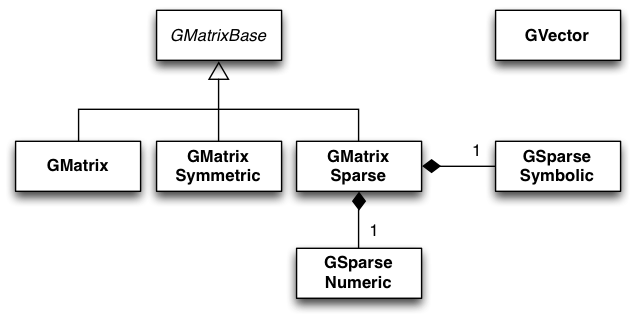Linear algebra¶
Overview¶
The following figure presents an overview over the C++ classes of the linear algebra module and their relations.
The linear algebra module provides classes for vector and matrix manipulation. The GVector class implements a double precision floating point vector, the classes GMatrix, GMatrixSymmetric and GMatrixSparse implement a matrix of double precision floating point values for a generic matrix, a symmetric matrix and a sparse matrix, respectively. All matrix classes derive from the abstract GMatrixBase base class that provides common functionalities to all matrix classes.
The classes GSparseNumeric and GSparseSymbolic are classes that are used by GMatrixSparse but these classes are not exposed to the outside world (i.e. the class definitions are not part of the GammaLib interface).
Matrix Storage classes¶
Three matrix storage classes are implemented:
- GMatrix implements a plain matrix storage class which stores all elements of the matrix in memory;
- GMatrixSymmetric implements a symmetric matrix storage class which stores only a triangle of matrix elements, imposing thus strict matrix symmetry;
- GMatrixSparse implements a sparse matrix storage class which stores only non-zero matrix elements in a column-wise organisation.
Storage class conversion constructors exist for all three classes to transform one storage class into another:
1 2 3 | GMatrix plain(10,10);
GMatrixSymmetric symmetric(plain);
GMatrixSparse sparse(symmetric);
|
In the above example, a plain matrix is instantiated in line 1, the plain matrix is converted into a symmetric matrix in line 2, and the symmetric matrix is converted into a sparse matrix in line 3. Additional complementary storage class conversion constructors exist, but conversion to a symmetric matrix is of course only possible if the matrix is indeed symmetric.
Matrix elements are accessed using the operator(). Filling of
sparse matrix elements using this operator is possible, although this
can be time consuming due to internal memory management. In general,
each fill of a new non-zero element needs to shift all elements
that are located after that element in memory.
To reduce the memory management overhead in the filling of a sparse matrix, methods have been implemented that allow to fill a matrix column wise:
1 2 3 4 5 6 7 | GMatrixSparse sparse(10,5);
GVector column(10);
column[0] = 1.0;
column[1] = 2.0;
column[5] = 8.0;
sparse.column(0, column);
sparse.add_to_column(0, column);
|
Line 1 allocates a sparse matrix with 10 rows and 5 columns, line 2 instantiates a vector with 10 elements. In lines 3-5, 3 elements of the vector are set to specific values, all other elements will default to 0. In line 6, the elements of the vector are set as the elements of the first matrix column (column 0). Line 7 differs from line 6 in that the elements are now not set but added to the existing matrix elements.
To further reduce the memory management overhead for the column-wise fill of a sparse matrix, a “fill-stack” has been implemented. The “fill-stack” is a buffer that implements a queue for columns that are to be set or added to the matrix. The columns will be stored in this “fill-stack” in the order they are provided, and only once the “fill-stack” is full, or upon request, the “fill-stack” will be flushed into memory. The “fill-stack” is used as follows:
sparse.stack_init(size, entries);
...
sparse.column(0, column);
...
sparse.stack_flush();
...
sparse.stack_destroy();
The stack_init(size, entries) method initialises the “fill-stack”,
where size is the size of the allocated memory buffer and entries
is the maximum number of columns that will be held by the buffer.
If size is set to 0 (the default value), a default size value of
512 is used. If entries is set to 0 (the default value), the number of
matrix columns is taken as default entries value. Note that a too large
number of elements will produce some overhead due to “fill-stack”
management, hence entries should not exceeed a value of the order of
10-100.
The stack_flush() method flushes the stack, which is mandatory
before any usage of the matrix. Note that the “fill-stack” is not
inserted automatically before any matrix operation, hence manual stack
flushing is needed to make all filled matrix elements available for usage.
The stack_destroy() method will flush the stack and free all stack
elements. This method should be called once no filling is required anymore.
If stack_destroy() is called immediately after filling, no call to
stack_flush() is needed as the stack_destroy() method flushes the
stack before destroying it. The matrix stack is also destroyed by the
sparse matrix destructor, hence manual stack destruction is not
mandatory.

